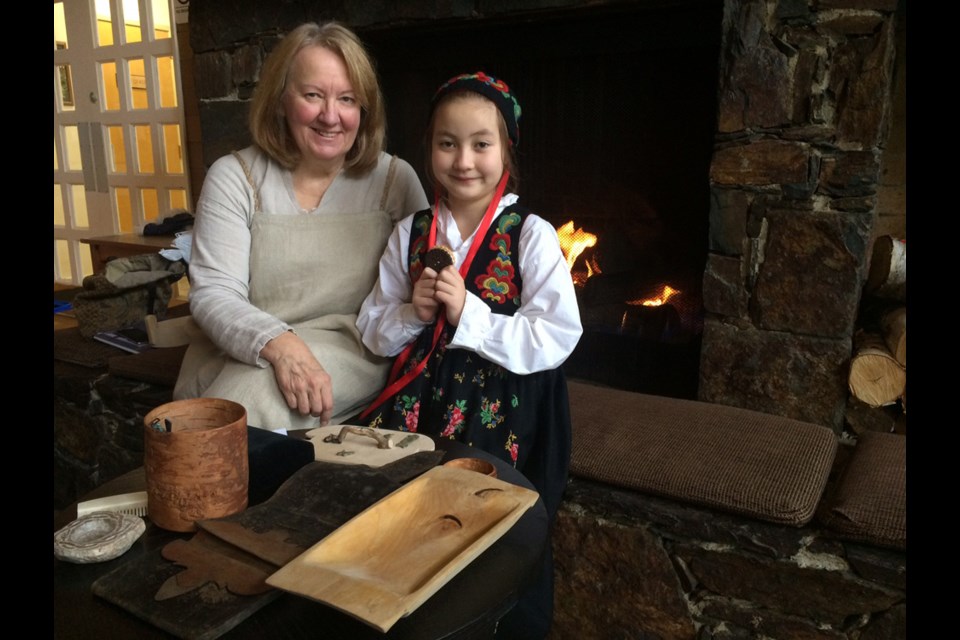Profile: Carolyn Thauberger
Occupation: retired teacher
Passion: Nordic costumes and textiles
Why she’s in the news: For Carolyn Thauberger, Nordic design is a family affair. The third-generation Canadian has Norwegian family roots and she volunteers at Burnaby’s Scandinavian Centre. She’s also one of the organizers of Nordic Design 2016, a showcase of Nordic clothes and textiles from centuries past to contemporary fashion. The two-day event will feature vintage clothes, jewelry and folk costumes. There will also be Viking reenactors. Thauberger plans to bring some of her family heirlooms to the event.
Can you tell me a little bit about what you’re wearing today?
I’m dressed as a Norse person, a Norse woman from the year 1000.
And it’s a slave outfit, is that right?
This is a basic costume. Slaves would have had very short skirts. They didn’t waste fabric on a slave, a thrall. If I were a regular Norse lady, my gown would go to the floor, and if I were the wife of a jarl, my gown would traipse around behind me.
And what about your granddaughter’s dress?
She’s wearing a folk costume now, we call it, but this is the garment that children and adults wore up to the 1850s or ‘60s, depending how far back into Norway their valley was. Each valley had its own costume, and if you crossed over the mountain onto the other side, the costume would look entirely different.
So you could tell where this dress was from, just by the embroidery?
Yes, precisely by the cut, the colour, the style of embroidery. You could tell from the hat whether she was a married lady or a young unmarried girl, because a young unmarried girl had her hair sticking out. And an older, married lady very likely had her hair bundled up underneath and wasn’t showing.
How much is this dress worth?
This dress would be $4,000, something like that, with the jewelry that goes with it. There’s some silver and pewter jewelry that’s here.
That’s expensive.
The fabric is handwoven wool, handwoven by a lady or a man on a loom in Norway. So, it takes a little while to put the costume together. …
Can you tell me what interesting things people will see at this upcoming show?
We have garments that are 300 years old that are coming on display. We have a piece of a hat that was from 1750. We have a christening gown from 1900, there was some talk of a wedding dress from the same era.
So these are people’s personal family heirlooms that will be on display?
Yes, some of them are on their way to museums; others are still in current use. We’re going right up to current fashions.
What do you hope people get out of this show?
We’re advertising mainly in the Scandinavian community. We want people to be aware of their own design heritage, so when they’re furnishing their homes, they will have a natural sense of Scandinavian design. … We want them to see their designs and be proud of their cultural heritage, and we want them to bring their grandchildren.
Why do you think it’s important that your granddaughter, Julianna here for example, learns about the clothes and the heritage?
You need to have a sense of yourself. First Nations people in British Columbia are working very hard to get a sense of themselves, to know where they fit into the world, where they belong. It is the same for all of the cultures. Julianna has a mother from China and a father who has some mixed European heritage, so she’s learning Chinese cooking, and she’s got a Norwegian folk costume, and she’s learning some words of Austrian, … a cultural heritage helps a person define themselves.
Julianna, what do you think about learning all the culture and heritage through the clothes and the fabrics? Is it interesting for you?
Yes, because you’re learning about people that first walked the earth, like early time people, and how they used to do things, how they used to hunt, eat and party.
Event details
- What: Nordic Design 2016, a textiles and fashion show with displays from Denmark, Finland, Norway, Sweden, Iceland. Contemporary fashion, vintage clothes and folk costumes. Some vendors onsite.
- When: Saturday, Feb. 27 and Sunday, Feb. 28, from 11 a.m. to 4 p.m. Opening reception on Saturday, at 11:30 a.m. with concert, speakers and dignitaries. Fashion runway show on Saturday, at 7 p.m.
- Where: Scandinavian Community Centre, 6540 Thomas St.
- Admission: Exhibit is free, fashion show tickets are $10.
- Details: Have something Nordic in your closet? Wear it to Saturday’s fashion show. Also note, seating is limited, and this event will likely be at capacity.



